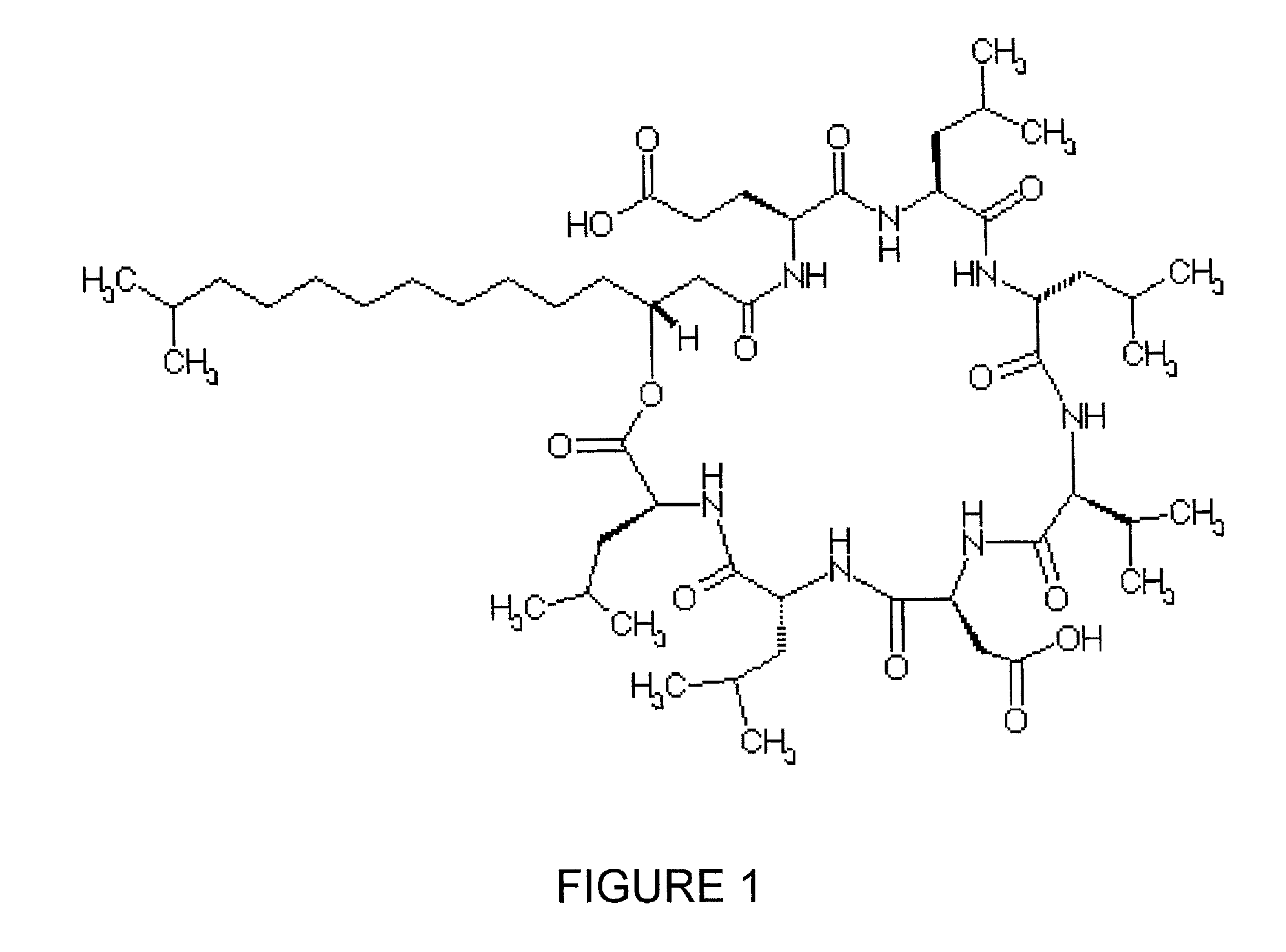Method for improving the cleaning action of a detergent or cleaning agent
a technology of cleaning action and cleaning agent, which is applied in the direction of anionic surface active compounds, organic detergent compounding agents, detergent compositions, etc., can solve the problems of not having satisfactory hydrolytic activity and not showing optimal cleaning performance, and achieve the effect of improving the cleaning performance of washing
- Summary
- Abstract
- Description
- Claims
- Application Information
AI Technical Summary
Benefits of technology
Problems solved by technology
Method used
Image
Examples
example 1
[0088]The general formulation indicated in TABLE 2 below is a textile washing agent used to ascertain washing performance.
TABLE 2Textile Washing AgentIngredientwt % pure substanceXanthan0.3 to 0.5Anti-foaming agent0.2 to 0.4Glycerol6 to 7Ethanol0.3 to 0.5FAEOS4 to 7Nonionic surfactant (FAEO,24 to 28APG, amongst others)Boric acid1 Sodium citrate (dihydrate)1 to 2Soda2 to 4Coconut fatty acids14 to 16HEDP0.5PVP 0 to 0.4Optical brightener 0 to 0.05Dye 0 to 0.001Perfume0 to 2H2O, demineralizedremainder
[0089]The test formulations were assembled in 48-well plates, each in 1 ml of washing bath, as indicated in TABLE 3. Incubation occurred for 60 minutes at 40° C. with stirring (approx. 600 revolutions per minute (rpm)).
TABLE 3Test FormulationsVolumeSolution420μl161 to 966 mg textile washing agentin 42 ml water or buffer30 to 530μl1 to 100 PU / ml protease30 to 530μlPrepared substance solutionremainderH2OStain diameter approx. 1 cm
[0090]Round stain pieces (diameter approx. 10 mm) were use...
example 2
[0093]Washing performance was tested using the following pure substances (component (b)): polyglutamate (polyglutamic acid), lysine, phenylalanine, tyrosine, alanine, leucine, proline, cysteine, threonine, serine, glycine, aspartate, asparagine, 2,3-butanediol, pyruvate, propionate, butyrate, levan, and surfactin.
[0094]Stock solutions with these substances were prepared, having 0.00001 to 1.5 M substance or 0.0001 to 55% (weight) in water or buffer (phosphate 0.00001 to 1.5 M, pH 6.5 to 8.0, or Tris 0.00001 to 1.5 M, pH 7.5 to 9.0, or Sorensen's buffer pH 7.5 to 9.0, or citrate buffer 0.00001 to 1.5 M, pH 4.5 to 7.0, or acetate buffer 0.00001 to 1.5 M, pH 2.5 to 5.5).
[0095]TABLE 4 through TABLE 9 below show the washing performance results obtained for the experimental formulations indicated (the abbreviation “n.d.” denotes “not determined”). The amino acids are listed using standard abbreviations. It is evident that the components (b) that are used produce a synergistic increase in ...
example 3
[0096]Washing performance was increased with bacterial or fungal fermenter supernatants and nutrient media (culture supernatants) or fractions from the purification of these liquids, in particular with Bacillus fermenter supernatants and Bacillus nutrient media (culture supernatants) and fractions that contain such substances.
[0097]Fermenter cultures were centrifuged or not centrifuged in order to separate out solids, and boiled (15 min., 97.5 to 100° C.) in order to inactivate the enzymes. Once the broth had been boiled, the resulting solution was centrifuged again in order to separate out the precipitate that had formed (=boiled supernatant). The boiled supernatant was further treated, as applicable, by being filtered using a 10 kDa cutoff membrane, then through a 1 kDa cutoff membrane. The filtrate of the 1 kDa cutoff membrane was further fractionated using a Bio-Gel P2 column (gel permeation chromatography / size exclusion chromatography).
[0098]Culture supernatants or dilutions of...
PUM
| Property | Measurement | Unit |
|---|---|---|
| molecular weight | aaaaa | aaaaa |
| molecular weight | aaaaa | aaaaa |
| temperature | aaaaa | aaaaa |
Abstract
Description
Claims
Application Information
 Login to View More
Login to View More - R&D
- Intellectual Property
- Life Sciences
- Materials
- Tech Scout
- Unparalleled Data Quality
- Higher Quality Content
- 60% Fewer Hallucinations
Browse by: Latest US Patents, China's latest patents, Technical Efficacy Thesaurus, Application Domain, Technology Topic, Popular Technical Reports.
© 2025 PatSnap. All rights reserved.Legal|Privacy policy|Modern Slavery Act Transparency Statement|Sitemap|About US| Contact US: help@patsnap.com

